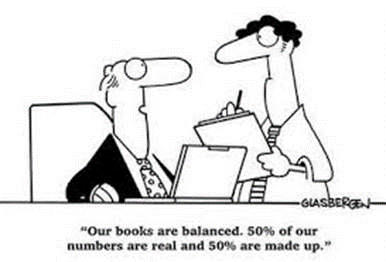
Firstly, don’t get overwhelmed! There are many, many pages required by legislation but there are really only 2 pages of significance – your Profit & Loss Statement (P&L) and Balance Sheet (also referred to formally as the ‘Statement of Financial Performance’ and ‘Statement of Financial Position’).
The P&L tells you what the profit (or loss) is for the stated period – usually at year end on 31 March.
The Balance Sheet is a snapshot of assets and liabilities of the business as at a certain date – usually 31 March.
The P&L is required for tax purposes and is also a useful tool to see how well, or not, your business is performing. Sometimes outside influences, or things that are outside your control, can affect this – for example Covid 19 and the Christchurch earthquakes. Sometimes these outside influences can be a good thing for business. Often, an unexpected event has a temporary impact and the business will return to a more normal trading pattern after a period of time. For this reason, it’s very useful to compare P&L’s from different years to more accurately view the effect of these fluctuations and not become dependent upon them to continue at the current rate (whether negative or positive).
Another important fact to bear in mind is that after a year of increased profits, a year of increased taxes will follow. I foresee some surprises in this area in 2021!
A P&L will begin with the ‘meaty’ trading area – where sales are matched with the purchase of material necessary for those sales (cost of goods) as well as wages. When you subtract those costs from sales, you’re left with a ‘gross margin’. Gross margin will vary between industries and also types of clientele. For example, The Warehouse will have a much lower gross margin than Harvey Norman, as The Warehouse is relying on thousands of sales of low value items each day.
Next, the P&L will show your ‘overheads’ deducted from the gross margin. ‘Overheads’ include things like advertising, freight, rent, phone, electricity, insurance etc. These may be in the form of direct or indirect expenses. Direct expenses are those items that have a direct effect on turnover like advertising and freight. Indirect expenses are things like insurance or rent – meaning no matter how much you sell, these overheads always remain the same. (One exception is in the instance where you sell so much that you require more space, so rent increases and then your insurance cover needs to increase.)
Finally, the P&L will show ‘depreciation’ being deducted. This is IRD specific rates applied to different assets and is representative of wear and tear as the asset ages and technology improves. NOW you’ll see your ‘net profit’ figure. This is what you pay income tax on. If you are a sole trader, this figure gets included in your personal income tax return. If you trade as a company, it may be split into shareholder salaries and dividends or remain as retained earnings in the company. A good P&L would show an improving net profit position over time, with explanations provided for when it doesn’t go according to plan. A good accountant will indicate when your costs and expenses are out of kilter with expected norms for your industry.
The Balance Sheet shows ‘assets’ which include: stock, debtors/receivables, cash in the bank, plant – computers, vehicles (fixed assets) and goodwill on the purchase of a business. It also shows ‘liabilities’ which include: bank overdraft, creditors/payables, deposits received in advance for work not yet done and loan/hire purchase obligations.
A good balance sheet would have:
- more debtors and stock than creditors
- bank balance within limits bank agreed to and fluctuates regularly
- fixed assets in excess of loans/hire purchase
- reducing debt each year
- shareholders fund account in credit, meaning the business owes you money, not you owing the business money
Regular review of your financial reports allows you to monitor these balances so that they look good for the bank when you require their assistance – during a rough patch OR for expansion.
Being able to read financial statements will ensure you are more in-tune with your business and will help you understand how they will change when different circumstances arise (for example, a large customer doesn’t pay you, so your debtors are high and the bank balance is low). Your bank manager will have more respect for you when you can talk sensibly about the financial state of your business – in fact, you could end up knowing more than them! I believe this knowledge is always good, as it puts you in a more powerful position!
You can learn more about how Raelene helps her clients here: https://www.reesaccounting.co.nz/



